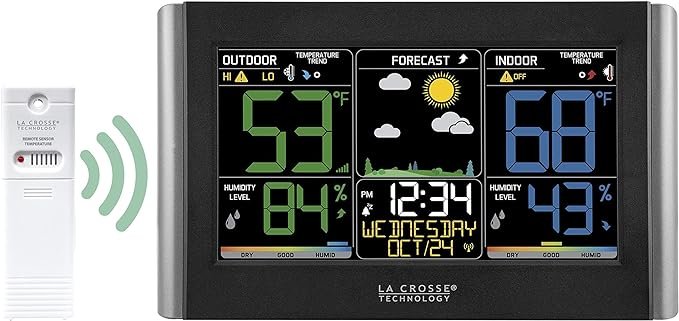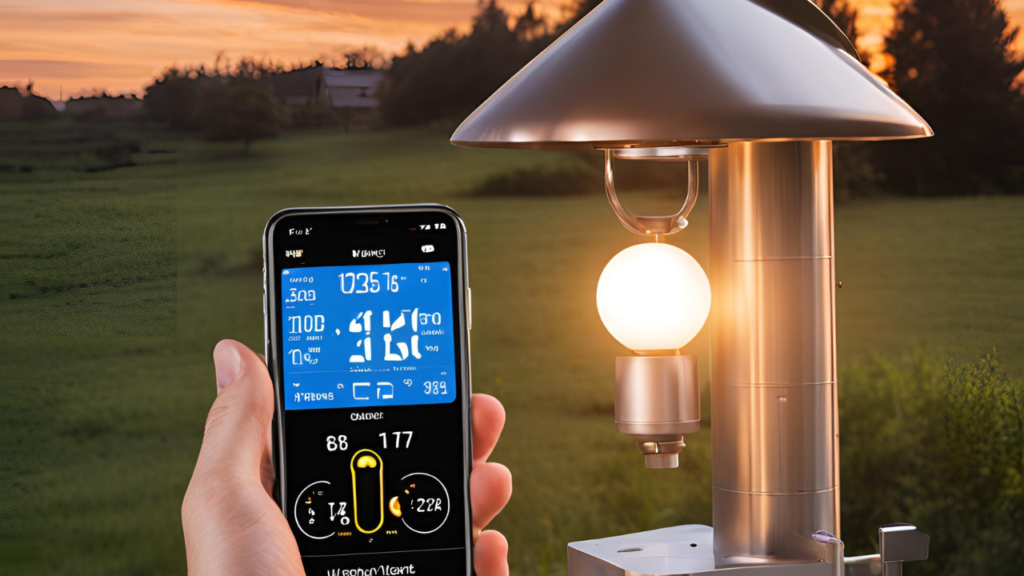
Did you know that over 70% of homeowners consider weather monitoring essential for their property management?
Solar-powered weather stations for outdoor use have changed how we track and understand local weather patterns.
These devices are not just for weather enthusiasts – they’re becoming increasingly popular among gardeners, farmers, and outdoor adventurers alike.
In this article, we will be exploring the best solar-powered weather stations for outdoor environments, their incredible features, and how they can transform your weather monitoring experience.
What are the Best Solar-Powered Weather Stations for Outdoor Use?
Before diving into the best solar-powered weather stations for outdoor use, we are going to talk about what these solar weather stations are and how they work.
This device uses solar energy(from the sun) to power its operations.
Making them fit for any outdoor adventure because they are powered by renewable energy and have advanced weather monitoring technology.
Key Components of Outdoor Solar-Powered Weather Stations:
- Solar Panel: Captures sunlight and converts it into electrical energy
- Rechargeable Battery: Stores energy for use during cloudy days or at night
- Weather Sensors: Measure various parameters like temperature, humidity, and wind speed
- Data Logger: Records and stores weather information
- Transmission Unit: Sends data to your display console or smartphone
Best Solar-Powered Weather Stations for Outdoor Use in 2024
Now, let’s dive into some of the top-rated solar-powered weather stations available for outdoor enthusiasts this year:
NOTE: THEY CAN BE CONNECTED TO SOLAR PANELS

Ambient Weather WS-2902C Osprey~ Best Overall

- Key Features:
- Wireless Connectivity: Enjoy seamless data transmission with wireless capabilities.
- Wi-Fi Enabled: Connect to your home network and access real-time weather data remotely.
- .Extended Transmission Range: Monitor conditions up to 330 feet away, perfect for larger outdoor spaces.
- .Temperature Monitoring: Track a wide range of temperatures, from -40 to 149 °F outdoors and 14 to 140 °F indoors.
- Comprehensive Weather Display: Stay informed with detailed readings on wind speed and direction, temperature, humidity, rainfall, UV index, and solar radiation.
- Pros:
- Exceptional accuracy and reliability
- User-friendly interface with customizable alerts
- Robust construction for extreme weather conditions
- Wireless tablet
- Ambient app
- Cons:
- No way to export data
- Digital display
- Complex setup process for advanced features
- The Ambient Weather WS-2902C Osprey is the Ferrari of outdoor solar powered weather stations. It’s pricey, but the data quality and features are unmatched!

Ambient Weather WS-2000~Top Premium Weather Station

The Ambient Weather WS-2000 delivers near-flawless data, closely mirroring local weather stations.
Its easy-to-read LCD tablet display, with customizable settings, stands out among competitors, and it supports advanced features like data archiving, sensor upgrades, and compatibility with IFTTT, Alexa, and Google Assistant.
However, the WS-2000 comes with a hefty price tag, a more complex setup process, and the need for a corded power supply for the display.
Despite these drawbacks, it remains the top choice for serious weather enthusiasts, with the WS-2902C Osprey offering a less expensive alternative with excellent performance.
- Key Features:
- Wireless Functionality: Effortless setup and operation with wireless technology.
- Wi-Fi Connectivity: Stay connected and monitor your weather data from anywhere with Wi-Fi integration.
- Long Transmission Range: Reliable performance with a 330 ft transmission range, ideal for expansive outdoor areas.
- Wide Temperature Range: Accurately measure temperatures from -40 to 149 °F outdoors and 14 to 140 °F indoors.
- Comprehensive Data Display: Get real-time updates on wind speed, wind direction, temperature, humidity, rainfall, UV levels, and solar radiation
Pros:
Experience clear and detailed weather data with a fantastic LCD screen.
Easily archive and export your weather data for detailed analysis
Packed with numerous features to meet all your weather tracking needs.
Ambient Weather Network: Connect with the Ambient Weather Network to share and compare data with a global community.
Cons:
- Premium Pricing: A higher price point reflecting its advanced capabilities.
- Complex Setup: Installation may require extra time and effort due to its sophisticated features.
- Corded Power Supply: The display unit requires a wired connection for power

La Crosse Technology Station~Top Value for Money

The La Crosse Technology C85845-1 offers great value with a sleek display and essential weather info, including dew point and heat index.
It’s accurate for its price but lacks wind speed and a rain gauge.
For a similar but slightly cheaper option, consider the La Crosse 308-1414B, which has a less vibrant display.
- Key Features:
- Wireless Capability: Allows for seamless operation without the hassle of wires
- No Wi-Fi: This model operates independently of Wi-Fi connectivity.
- .Transmission Range: Effective monitoring up to 300 feet away.
- Temperature Monitoring: Measures indoor temperatures from 32˚F to 122˚F (0˚C to 50˚C) and outdoor temperatures from -40˚F to 140˚F (-14˚C to 60˚C).
- Detailed Display: Provides real-time information on temperature highs and lows, humidity, time and date, heat index, dew point, and battery status.
- Pros:
- Simple to use
- Cheap
- Slim Design
- Cons:
- Doesn’t measure wind or rain
- Not the most accurate model tested

AcuRite Iris Weather Station~ Best For Accuracy
Key Features:
- Wireless: Yes, ensuring a hassle-free setup without the need for physical connections.
- Wi-Fi: No, meaning the station does not connect to the internet for remote monitoring.
- Transmission Range: Up to 330 feet, allowing for reliable data transmission over a significant distance.
- Temperature Range: Indoor temperatures from 32 to 122°F (0-50°C) and outdoor temperatures from -40 to 158°F, covering a broad spectrum of conditions.
- Display: Features comprehensive information, including current temperature, humidity levels, wind speed and direction, rainfall, dew point, barometric pressure, as well as the date and time.
| Pros | Cons |
|---|---|
| Lightning detection | Plastic Mounting Pole: Screws can strip the plastic. |
| Easy display setup | Forecast Icon: May lack accuracy. |
| Five-in-one sensor | |
| Real-time weather ticker | |
| Great value |
CLICK TO VIEW THE TOP PORTABLE SOLAR PANELS FOR OUTDOOR USE
Advantages of Solar Weather Stations Over Traditional Weather Stations:
- Energy Independence: No need for external power sources or frequent battery changes
- Eco-friendly: Utilizes renewable energy, reducing carbon footprint
- Flexibility in Placement: Can be installed in remote locations without access to the power grid
- Low Maintenance: Fewer components that can fail compared to wired systems
- Cost-Effective: Saves on electricity bills and battery replacements in the long run

Top Features of Outdoor Solar-Powered Weather Stations
When it comes to choosing the best solar-powered weather station for your outdoor usage, certain features stand out from the crowd.
Let’s explore what makes these devices so special:
- Real-time Data Collection and Transmission:
Using modern solar-powered weather stations in your outdoor environments offer instant weather updates, allowing you to stay informed about changing conditions. - Wireless Connectivity and Smartphone Integration:
Many outdoor solar powered weather stations come with Wi-Fi or Bluetooth capabilities, enabling easy data access through dedicated smartphone apps. - Multiple Sensor Types:
- Temperature and Humidity Sensors
- Wind Speed and Direction Sensors (Anemometer)
- Rainfall Gauge
- Barometric Pressure Sensor
- UV Index Sensor
- Solar Radiation Sensor
4. Durable Construction:
The best solar powered weather stations for outdoor use are built to withstand harsh weather conditions, featuring corrosion-resistant materials and robust designs.
5. Long-lasting Battery Life with Solar Recharging:
High-capacity batteries coupled with efficient solar panels ensure your weather station keeps running even during extended periods of low sunlight.
6. Expandability:
Some advanced outdoor solar powered weather stations allow you to add extra sensors or integrate with other smart home devices for enhanced functionality.

How to Choose the Right Solar Powered Weather Station for Outdoor Use
Selecting the perfect weather station for your needs can be overwhelming. Here’s a guide to help you make an informed decision:
Assess Your Specific Weather Monitoring Needs:
- Are you a casual observer or do you need professional-grade data?
- What specific weather parameters are most important to you?
- Do you need to monitor multiple locations?
Consider Your Budget and Long-term Value:
- While premium outdoor solar powered weather stations offer more features, there are excellent options at various price points.
- Factor in potential savings on energy costs and battery replacements.
Evaluate the Station’s Accuracy and Reliability:
- Look for stations with high-precision sensors and regular calibration options.
- Check for certifications or comparisons with official weather stations.
Check for Compatibility with Your Existing Devices:
- Ensure the solar powered weather station works with your smartphone or smart home system.
- Consider future-proofing by choosing a station with update capabilities.
Read User Reviews and Expert Opinions:
- Look for long-term reviews to gauge durability and performance over time.
- Pay attention to customer support experiences, as you may need assistance with your outdoor solar powered weather station.

Installation and Maintenance Tips for Outdoor Solar Powered Weather Stations
Once you’ve chosen your ideal solar powered weather station, proper installation and maintenance are next which are crucial for optimal performance:
- Choosing the Right Location:
- Select an open area away from buildings and trees for accurate readings.
- Ensure the solar panel receives maximum sunlight throughout the day.
- Consider ease of access for maintenance when selecting the mounting spot.
2. Proper Mounting Techniques:
- Use sturdy poles or masts that can withstand strong winds.
- Ensure the station is level and oriented correctly for accurate wind direction readings.
- Follow the manufacturer’s guidelines for height and spacing of sensors.
3. Regular Cleaning and Calibration:
- Clean solar panels, sensors, and rain gauges periodically to maintain accuracy.
- Recalibrate sensors according to the manufacturer’s recommendations.
- Check for software updates that may improve performance or add new features.
4. Troubleshooting Common Issues:
- Battery not charging: Check for obstructions blocking the solar panel.
- Inaccurate readings: Ensure sensors are clean and properly calibrated.
- Data transmission problems: Check wireless signal strength and network settings.
CLICK TO VIEW MY POST ON HOW TO POSITION YOUR SOLAR PANEL FOR OPTIMAL ENERGY
Applications of Solar Powered Weather Stations for Outdoor Use
These versatile devices have a wide range of applications beyond just casual weather watching:
- Agriculture and Farming:
- Optimize irrigation schedules based on local weather conditions.
- Predict frost events to protect crops.
- Monitor soil moisture and temperature for better crop management.
2. Home Gardening and Landscaping:
- Plan watering schedules for efficient water use.
- Choose the best times for planting and fertilizing.
- Protect sensitive plants from extreme weather conditions.
3. Outdoor Sports and Recreational Activities:
- Plan hiking, camping, or sailing trips with accurate local weather data.
- Assess conditions for wind-dependent sports like kitesurfing or paragliding.
- Ensure safety during outdoor events by monitoring severe weather threats.
4. Environmental Research and Climate Studies:
- Collect long-term weather data for climate change research.
- Monitor microclimate conditions in specific ecosystems.
- Support citizen science projects with crowdsourced weather data.
5. Emergency Preparedness and Disaster Management:
- Provide early warnings for severe weather events.
- Assist in planning emergency responses based on local conditions.
- Monitor air quality during wildfires or industrial incidents.
CLICK TO KNOW THE ENVIROMENTAL INFLUENCE OF SOLAR GADGETS IF THEY ARE ACTUALLY ECO FRIENDLY

The Future of Solar-Powered Weather Stations for Outdoor Environments
As we all know technology continues to advance, so do the capabilities of solar powered weather stations. Let’s take a peek into what the future might hold for these weather stations:
- Integration with Smart Home Systems:
- Automated adjustment of home heating/cooling based on outdoor conditions.
- Smart irrigation systems that respond to real-time weather data.
- Voice-activated weather reports through smart speakers.
2. Improved AI-powered Weather Predictions:
- Hyper-local forecasts using machine learning algorithms.
- Personalized weather alerts based on user activities and preferences.
- Predictive maintenance notifications for your outdoor solar powered weather station.
3. Enhanced Data Visualization and Analytics:
- Virtual reality weather experiences using your local data.
- Interactive 3D weather maps for better understanding of conditions.
- Advanced trend analysis for long-term climate monitoring.
4. Miniaturization and Increased Portability:
- Wearable solar powered weather stations for outdoor enthusiasts.
- Drone-mounted weather stations for on-demand atmospheric profiling.
- Floating solar powered weather stations for marine applications.
5. Expanded Sensor Capabilities:
- Air quality and pollutant detection for urban environments.
- Lightning prediction and strike location mapping.
- Acoustic sensors for measuring precipitation intensity and type.

Conclusion
Solar powered weather stations for outdoor use have transformed the way we interact with and understand our local environment.
From providing crucial data for farmers to helping outdoor enthusiasts plan their activities, these innovative devices offer a wealth of benefits.
By choosing the best solar powered weather station for your outdoor needs, you’re investing in a gadget – you’re gaining valuable insights into the world around you while supporting sustainable technology.
Remember, whether you’re a casual observer or a serious weather enthusiast, there’s a perfect solar powered weather station for your outdoor monitoring needs. So why wait? Start your journey towards smarter, more sustainable weather tracking today!




